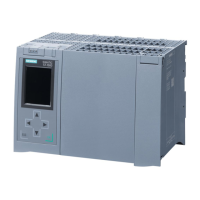Using PID_Temp
6.4 Cascade control with PID_Temp
PID control
Function Manual, 03/2017, A5E35300227-AC
197
After compiling and loading of the program, you can start commissioning of the cascade
control system.
Begin with the innermost slave at commissioning (implementation of tuning or change to
automatic mode with existing PID parameters) and continue outwards until the outermost
master has been reached.
In the above example, commissioning starts with PID_Temp_2 and is continued with
PID_Temp_1.
Tuning of PID_Temp requires a constant setpoint. Therefore, activate the substitute setpoint
of a slave (SubstituteSetpoint and SubstituteSetpointOn tags) to tune the slave or set the
associated master to manual mode with a corresponding manual value. This ensures that
the setpoint of the slave remains constant during tuning.
In order for a master to influence the process or to carry out tuning, all the downstream
slaves have to be in automatic mode and their substitute setpoint has to be deactivated. A
master evaluates these conditions through the interface for information exchange between
master and slave (Master parameter and Slave parameter) and displays the current state at
the AllSlaveAutomaticState and NoSlaveSubstituteSetpoint tags. Corresponding status
messages are output in the commissioning editor.
Status message in the commis-
sioning editor of the master
DB parameter of the master
One or more slaves are not in
automatic mode.
AllSlaveAutomaticState = FALSE,
NoSlaveSubstituteSetpoint = TRUE
First, carry out commissioning of all down-
stream slaves.
Ensure that the following conditions are
fulfilled before carrying out tuning or activat-
ing manual mode or automatic mode of the
master:
• All downstream slaves are in automatic
mode (state = 3).
• All downstream slaves have deactivated
the substitute setpoint (SubstituteSet-
pointOn = FALSE).
One or more slaves have activated
the substitute setpoint.
AllSlaveAutomaticState = TRUE,
NoSlaveSubstituteSetpoint = FALSE
One or more slaves are not in
automatic mode and have activat-
ed the substitute setpoint.
AllSlaveAutomaticState = FALSE,
NoSlaveSubstituteSetpoint = FALSE
If pretuning or fine tuning is started for a master, PID_Temp aborts tuning in the following
cases and displays an error with ErrorBits = DW#16#0200000:
● One or more slaves are not in automatic mode (AllSlaveAutomaticState = FALSE)
● One or more slaves have activated the substitute setpoint (NoSlaveSubstituteSetpoint =
FALSE).
The subsequent operating mode changeover depends on ActivateRecoverMode.

